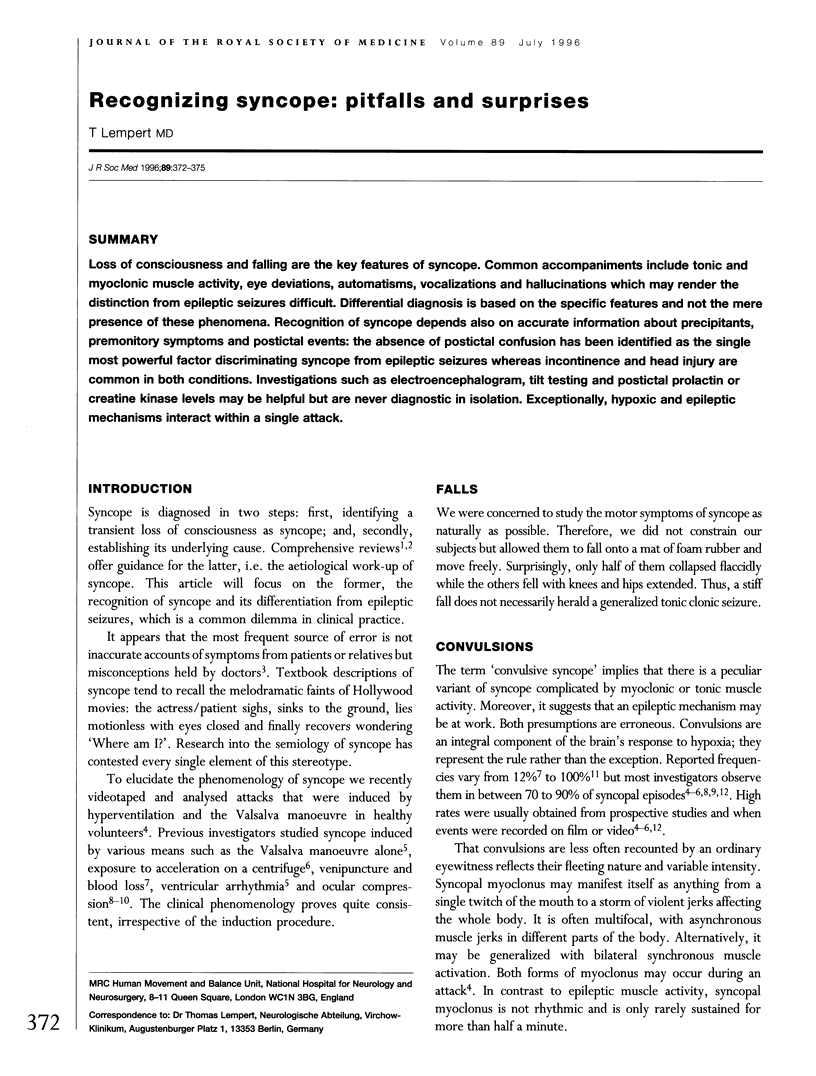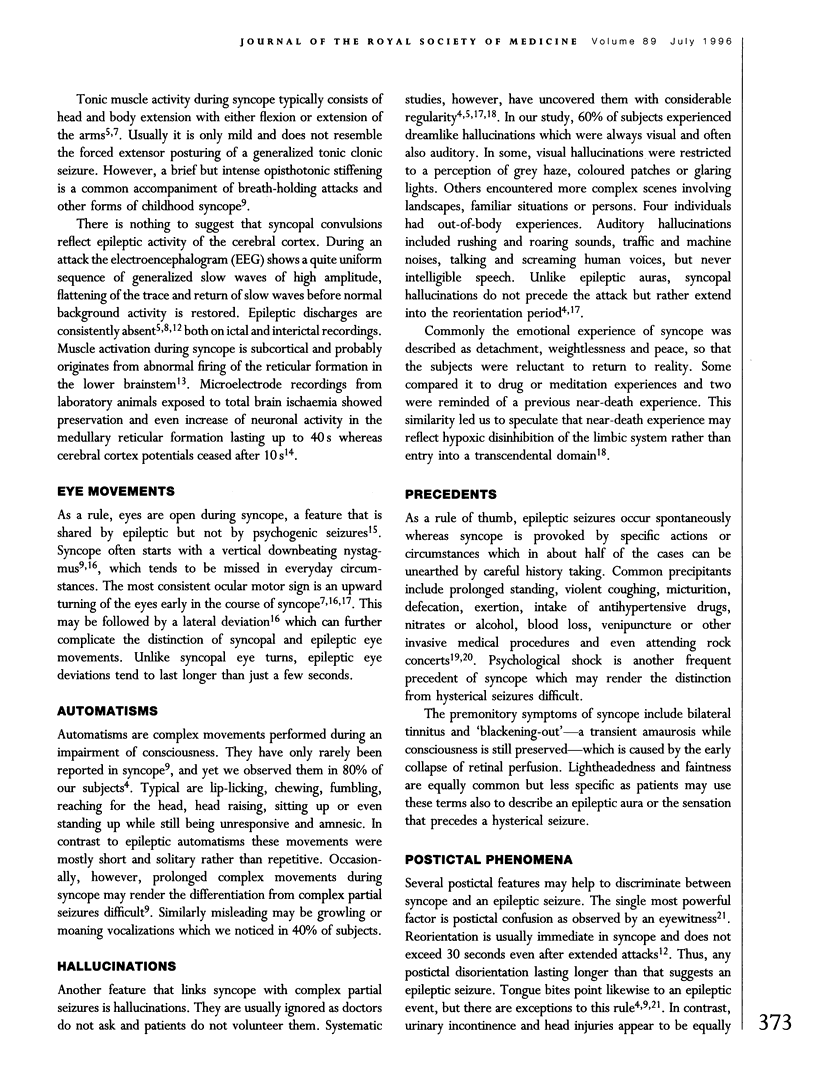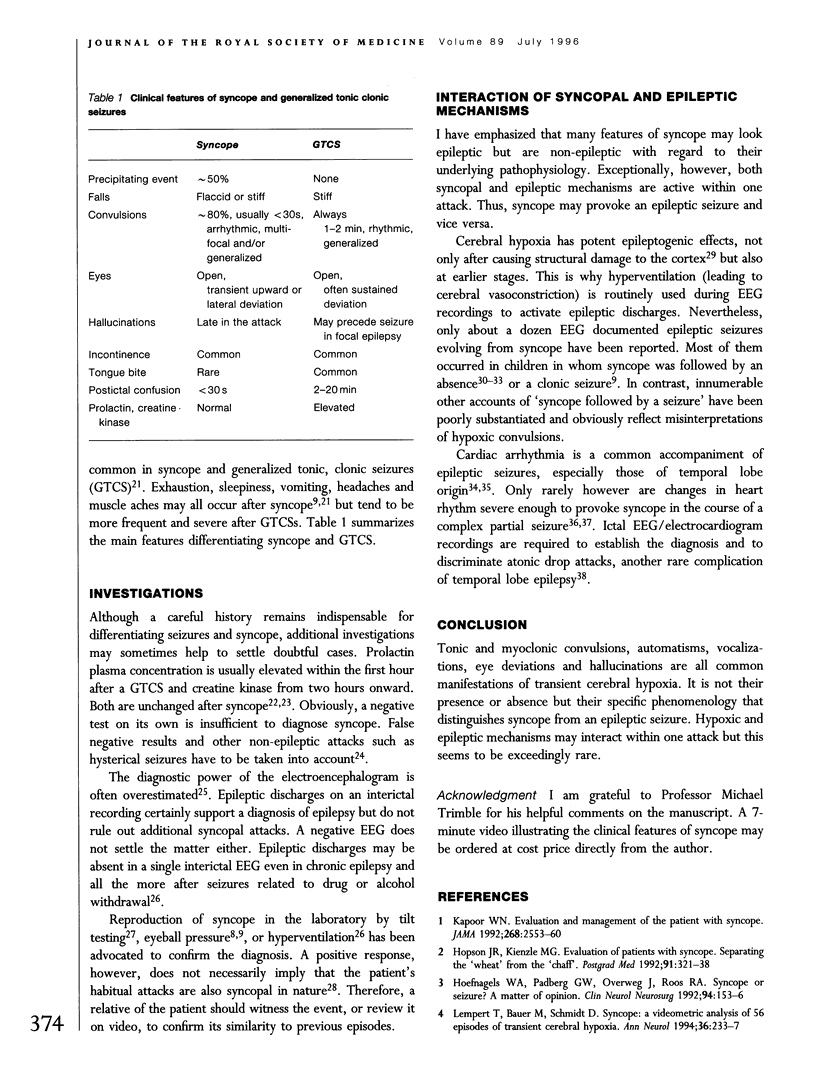Abstract
Loss of consciousness and falling are the key features of syncope. Common accompaniments include tonic and myoclonic muscle activity, eye deviations, automatisms, vocalizations and hallucinations which may render the distinction from epileptic seizures difficult. Differential diagnosis is based on the specific features and not the mere presence of these phenomena. Recognition of syncope depends also on accurate information about precipitants, premonitory symptoms and postictal events: the absence of postictal confusion has been identified as the single most powerful factor discriminating syncope from epileptic seizures whereas incontinence and head injury are common in both conditions. Investigations such as electroencephalogram, tilt testing and postictal prolactin or creatine kinase levels may be helpful but are never diagnostic in isolation. Exceptionally, hypoxic and epileptic mechanisms interact within a single attack.
Full text
PDF



Selected References
These references are in PubMed. This may not be the complete list of references from this article.
- Aicardi J., Gastaut H., Misès J. Syncopal attacks compulsively self-induced by Valsalva's maneuver associated with typical absence seizures. A case report. Arch Neurol. 1988 Aug;45(8):923–925. doi: 10.1001/archneur.1988.00520320125029. [DOI] [PubMed] [Google Scholar]
- Aminoff M. J., Scheinman M. M., Griffin J. C., Herre J. M. Electrocerebral accompaniments of syncope associated with malignant ventricular arrhythmias. Ann Intern Med. 1988 Jun;108(6):791–796. doi: 10.7326/0003-4819-108-6-791. [DOI] [PubMed] [Google Scholar]
- Anzola G. P. Predictivity of plasma prolactin levels in differentiating epilepsy from pseudoseizures: a prospective study. Epilepsia. 1993 Nov-Dec;34(6):1044–1048. doi: 10.1111/j.1528-1157.1993.tb02132.x. [DOI] [PubMed] [Google Scholar]
- Constantin L., Martins J. B., Fincham R. W., Dagli R. D. Bradycardia and syncope as manifestations of partial epilepsy. J Am Coll Cardiol. 1990 Mar 15;15(4):900–905. doi: 10.1016/0735-1097(90)90290-6. [DOI] [PubMed] [Google Scholar]
- Forster E. M., Whinnery J. E. Recovery from Gz-induced loss of consciousness: psychophysiologic considerations. Aviat Space Environ Med. 1988 Jun;59(6):517–522. [PubMed] [Google Scholar]
- GASTAUT H., FISCHER-WILLIAMS M. Electro-encephalographic study of syncope; its differentiation from epilepsy. Lancet. 1957 Nov 23;273(7004):1018–1025. doi: 10.1016/s0140-6736(57)92147-5. [DOI] [PubMed] [Google Scholar]
- Gambardella A., Reutens D. C., Andermann F., Cendes F., Gloor P., Dubeau F., Olivier A. Late-onset drop attacks in temporal lobe epilepsy: a reevaluation of the concept of temporal lobe syncope. Neurology. 1994 Jun;44(6):1074–1078. doi: 10.1212/wnl.44.6.1074. [DOI] [PubMed] [Google Scholar]
- Gastaut H., Zifkin B., Rufo M. Compulsive respiratory stereotypies in children with autistic features: polygraphic recording and treatment with fenfluramine. J Autism Dev Disord. 1987 Sep;17(3):391–406. doi: 10.1007/BF01487068. [DOI] [PubMed] [Google Scholar]
- Gibbs J., Appleton R. E. False diagnosis of epilepsy in children. Seizure. 1992 Mar;1(1):15–18. doi: 10.1016/1059-1311(92)90049-7. [DOI] [PubMed] [Google Scholar]
- Gilchrist J. M. Arrhythmogenic seizures: diagnosis by simultaneous EEG/ECG recording. Neurology. 1985 Oct;35(10):1503–1506. doi: 10.1212/wnl.35.10.1503. [DOI] [PubMed] [Google Scholar]
- Grubb B. P., Gerard G., Roush K., Temesy-Armos P., Elliott L., Hahn H., Spann C. Differentiation of convulsive syncope and epilepsy with head-up tilt testing. Ann Intern Med. 1991 Dec 1;115(11):871–876. doi: 10.7326/0003-4819-115-11-871. [DOI] [PubMed] [Google Scholar]
- Guerrini R., Battaglia A., Gastaut H. Absence status triggered by pallid syncopal spells. Neurology. 1991 Sep;41(9):1528–1529. doi: 10.1212/wnl.41.9.1528-b. [DOI] [PubMed] [Google Scholar]
- Hallett M., Chadwick D., Adam J., Marsden C. D. Reticular reflex myoclonus: a physiological type of human post-hypoxic myoclonus. J Neurol Neurosurg Psychiatry. 1977 Mar;40(3):253–264. doi: 10.1136/jnnp.40.3.253. [DOI] [PMC free article] [PubMed] [Google Scholar]
- Hoefnagels W. A., Padberg G. W., Overweg J., Roos R. A. Syncope or seizure? A matter of opinion. Clin Neurol Neurosurg. 1992;94(2):153–156. doi: 10.1016/0303-8467(92)90073-c. [DOI] [PubMed] [Google Scholar]
- Hoefnagels W. A., Padberg G. W., Overweg J., Roos R. A., van Dijk J. G., Kamphuisen H. A. Syncope or seizure? The diagnostic value of the EEG and hyperventilation test in transient loss of consciousness. J Neurol Neurosurg Psychiatry. 1991 Nov;54(11):953–956. doi: 10.1136/jnnp.54.11.953. [DOI] [PMC free article] [PubMed] [Google Scholar]
- Hoefnagels W. A., Padberg G. W., Overweg J., van der Velde E. A., Roos R. A. Transient loss of consciousness: the value of the history for distinguishing seizure from syncope. J Neurol. 1991 Feb;238(1):39–43. doi: 10.1007/BF00319709. [DOI] [PubMed] [Google Scholar]
- Hopson J. R., Kienzle M. G. Evaluation of patients with syncope. Separating the 'wheat' from the 'chaff'. Postgrad Med. 1992 Apr;91(5):321-8, 333, 336. doi: 10.1080/00325481.1992.11701298. [DOI] [PubMed] [Google Scholar]
- Kapoor W. N. Evaluation and management of the patient with syncope. JAMA. 1992 Nov 11;268(18):2553–2560. [PubMed] [Google Scholar]
- Kapoor W. N., Smith M. A., Miller N. L. Upright tilt testing in evaluating syncope: a comprehensive literature review. Am J Med. 1994 Jul;97(1):78–88. doi: 10.1016/0002-9343(94)90051-5. [DOI] [PubMed] [Google Scholar]
- Kothari S. S. When epilepsy masquerades as heart disease. Awareness is key to avoiding misdiagnosis. Postgrad Med. 1990 Nov 1;88(6):167, 170-1. doi: 10.1080/00325481.1990.11716430. [DOI] [PubMed] [Google Scholar]
- Lempert T., Bauer M. Mass fainting at rock concerts. N Engl J Med. 1995 Jun 22;332(25):1721–1721. doi: 10.1056/NEJM199506223322520. [DOI] [PubMed] [Google Scholar]
- Lempert T., Bauer M., Schmidt D. Syncope and near-death experience. Lancet. 1994 Sep 17;344(8925):829–830. doi: 10.1016/s0140-6736(94)92389-2. [DOI] [PubMed] [Google Scholar]
- Lempert T., Bauer M., Schmidt D. Syncope: a videometric analysis of 56 episodes of transient cerebral hypoxia. Ann Neurol. 1994 Aug;36(2):233–237. doi: 10.1002/ana.410360217. [DOI] [PubMed] [Google Scholar]
- Lempert T., von Brevern M. The eye movements of syncope. Neurology. 1996 Apr;46(4):1086–1088. doi: 10.1212/wnl.46.4.1086. [DOI] [PubMed] [Google Scholar]
- Libman M. D., Potvin L., Coupal L., Grover S. A. Seizure vs. syncope: measuring serum creatine kinase in the emergency department. J Gen Intern Med. 1991 Sep-Oct;6(5):408–412. doi: 10.1007/BF02598161. [DOI] [PubMed] [Google Scholar]
- Lin J. T., Ziegler D. K., Lai C. W., Bayer W. Convulsive syncope in blood donors. Ann Neurol. 1982 May;11(5):525–528. doi: 10.1002/ana.410110513. [DOI] [PubMed] [Google Scholar]
- Madison D., Niedermeyer E. Epileptic seizures resulting from acute cerebral anoxia. J Neurol Neurosurg Psychiatry. 1970 Jun;33(3):381–386. doi: 10.1136/jnnp.33.3.381. [DOI] [PMC free article] [PubMed] [Google Scholar]
- Oppenheimer S. M., Cechetto D. F., Hachinski V. C. Cerebrogenic cardiac arrhythmias. Cerebral electrocardiographic influences and their role in sudden death. Arch Neurol. 1990 May;47(5):513–519. doi: 10.1001/archneur.1990.00530050029008. [DOI] [PubMed] [Google Scholar]
- Stephenson J. B. Reflex anoxic seizures and ocular compression. Dev Med Child Neurol. 1980 Jun;22(3):380–386. doi: 10.1111/j.1469-8749.1980.tb03721.x. [DOI] [PubMed] [Google Scholar]
- Trimble M. R. Serum prolactin in epilepsy and hysteria. Br Med J. 1978 Dec 16;2(6153):1682–1682. doi: 10.1136/bmj.2.6153.1682. [DOI] [PMC free article] [PubMed] [Google Scholar]
- Whinnery J. E., Whinnery A. M. Acceleration-induced loss of consciousness. A review of 500 episodes. Arch Neurol. 1990 Jul;47(7):764–776. doi: 10.1001/archneur.1990.00530070058012. [DOI] [PubMed] [Google Scholar]


